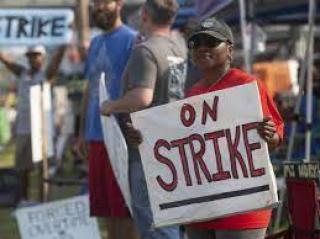Labor strikes aren’t cheap. Equipment sits idle. Supply chains get gummed up. Workers lose wages, shareholders lose profits, governments lose tax revenue. All these effects can have an adverse impact on economic growth, employment and inflation.
Both unionized workers and their employers know the costs of work stoppages. So why don’t they reach a deal before a strike occurs? And why has there been a surge in strikes and other labor actions, which were up more than 50% in 2022 and are on track to be even higher in 2023? The answer, in a word: uncertainty.
No one really knows how much bargaining power workers have right now, which means no one knows what workers can get from employers, which means that neither side wants to prematurely concede.
The traditional way to assess a tight labor market (and therefore bargaining power) is to look at how many unemployed people are waiting to take the jobs of people who leave them. By this metric, the labor market is historically tight, with an unemployment rate near a 50-year low. The rate has been below 4% since February 2022, even though economic and job growth has slowed.
This low unemployment rate led some economists to argue last year that the U.S. needed five years of unemployment above 5%, or that unemployment would need to reach 7.5% to beat inflation. The argument they make is that low unemployment keeps consumers spending money (which fuels inflation) and leads employers to hand out outsize wage increases (which also fuels inflation).
But this has not happened. Inflation has fallen from 9% to 3%, with unemployment remaining below 4%. And there have been very few signs that wages have sparked ongoing inflation.
That’s in part because the low unemployment is not happening in a stagnant labor market — it is happening in a labor market undergoing an extraordinary amount of upheaval. The number of people hired and voluntarily leaving jobs each month has been above pre-pandemic levels for most of the past three years.
Another metric often used to assess worker bargaining power is the ratio of unemployed people to job openings. This measure shows how many employers are looking for workers compared to how many idle workers are looking for jobs.
But most people taking open jobs are leaving other jobs for a new opportunity. And workers often return from being out of the labor force straight to employment, without spending time unemployed. Labor force participation has expanded more than most predicted, and a higher share of prime-age people are employed today than were before the pandemic. The labor market hasn’t needed a reserve army of unemployed people to contain wage pressures because the jobs have been filled by an expanding labor supply.
And so this metric, too, has provided little insight into the labor market. It surged as the U.S. recovered from the pandemic, peaking in early 2022. It has fallen substantially since then, with little impact on unemployment or wages.
Moreover, employers had to learn to be adaptable during the pandemic, and that adaptability might be making it easier for them to consider their options before giving big gains to workers. Even when they do, as happened last summer with UPS, the labor victory might be short-lived. The CEO of UPS recently told investors that the big increase in labor costs would be temporary because it is leaning into automation.
There is one more factor contributing to uncertainty around the bargaining power of unionized workers. Just how strong are unions these days? The unionization rate in the U.S. — just 6% of private-sector workers were union members in 2022, a record low — suggests an answer: not very.
On the other hand, public approval of labor unions remains near highs last seen in the mid-1960s after rising from an all-time low in 2009. Some 61% of Americans now say that unions help the overall economy, while 47% say they benefit nonunion workers as well.
And when it comes to strikes, Americans tend to side with the workers. An August poll found that three out of four side with the United Auto Workers. Most people can relate to the pain unionized workers are feeling from inflation. The UAW, for example, gave up cost-of-living increases in 2019, which may have made sense then but looks less smart in light of post-pandemic inflation rates. Overall, the wages of unionized workers have grown by much less than inflation, and by much less than those of their non-unionized peers. Large real pay cuts combined with high profits are making it clear that there is a lot to fight over.
Despite all the uncertainty, one thing is clear: The fight between workers and employers is just gearing up. As the public, the labor market and the overall economy continue to send mixed signals, and with the future of unions potentially at stake, don’t expect either side to blink anytime soon.










